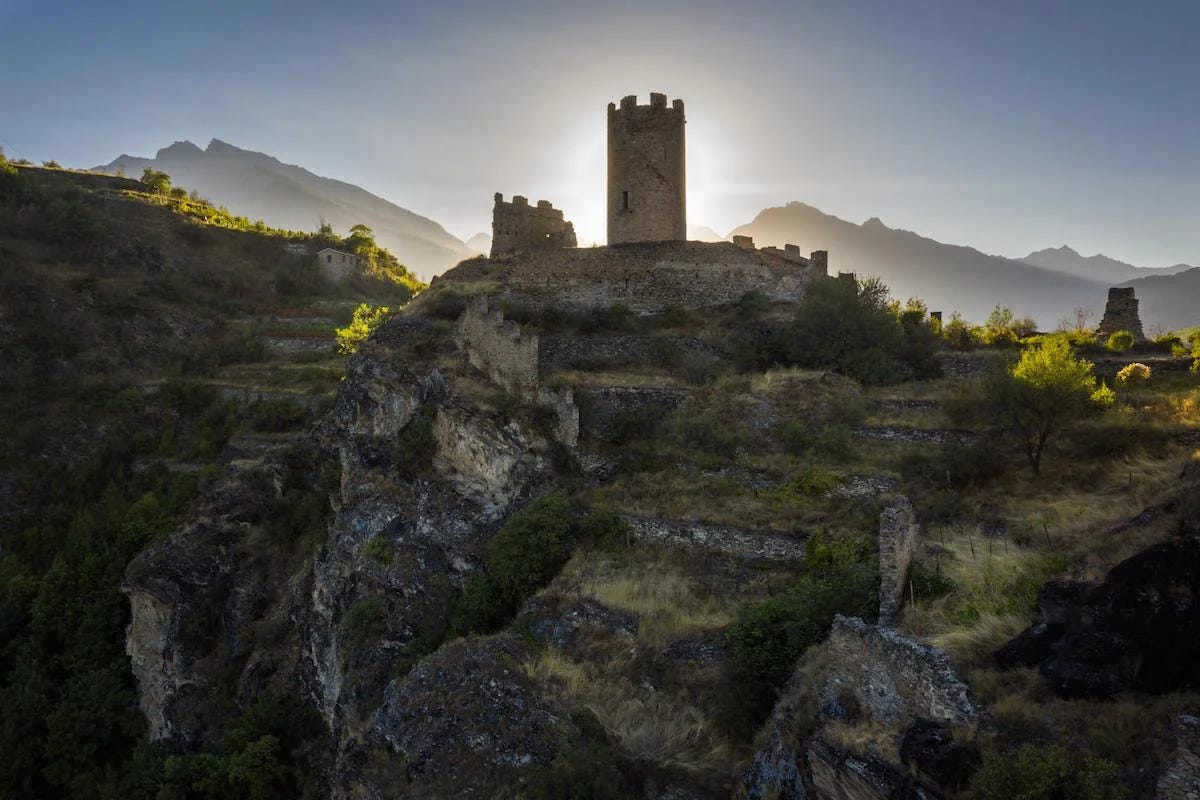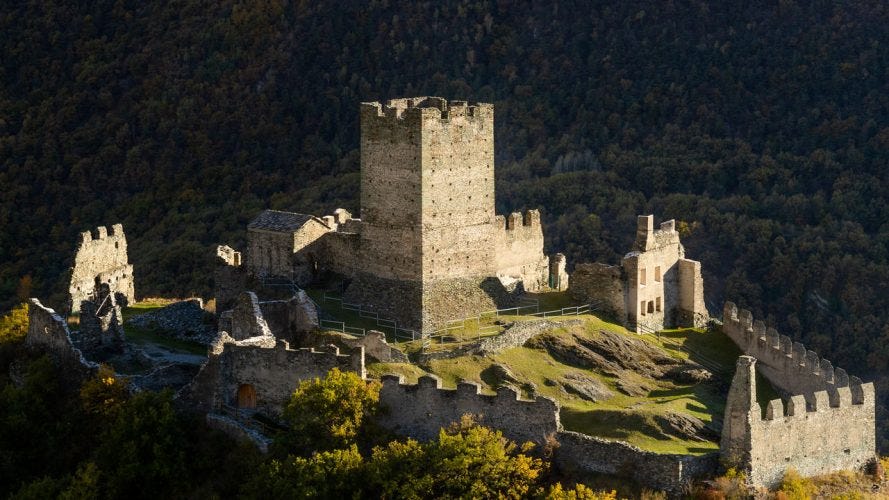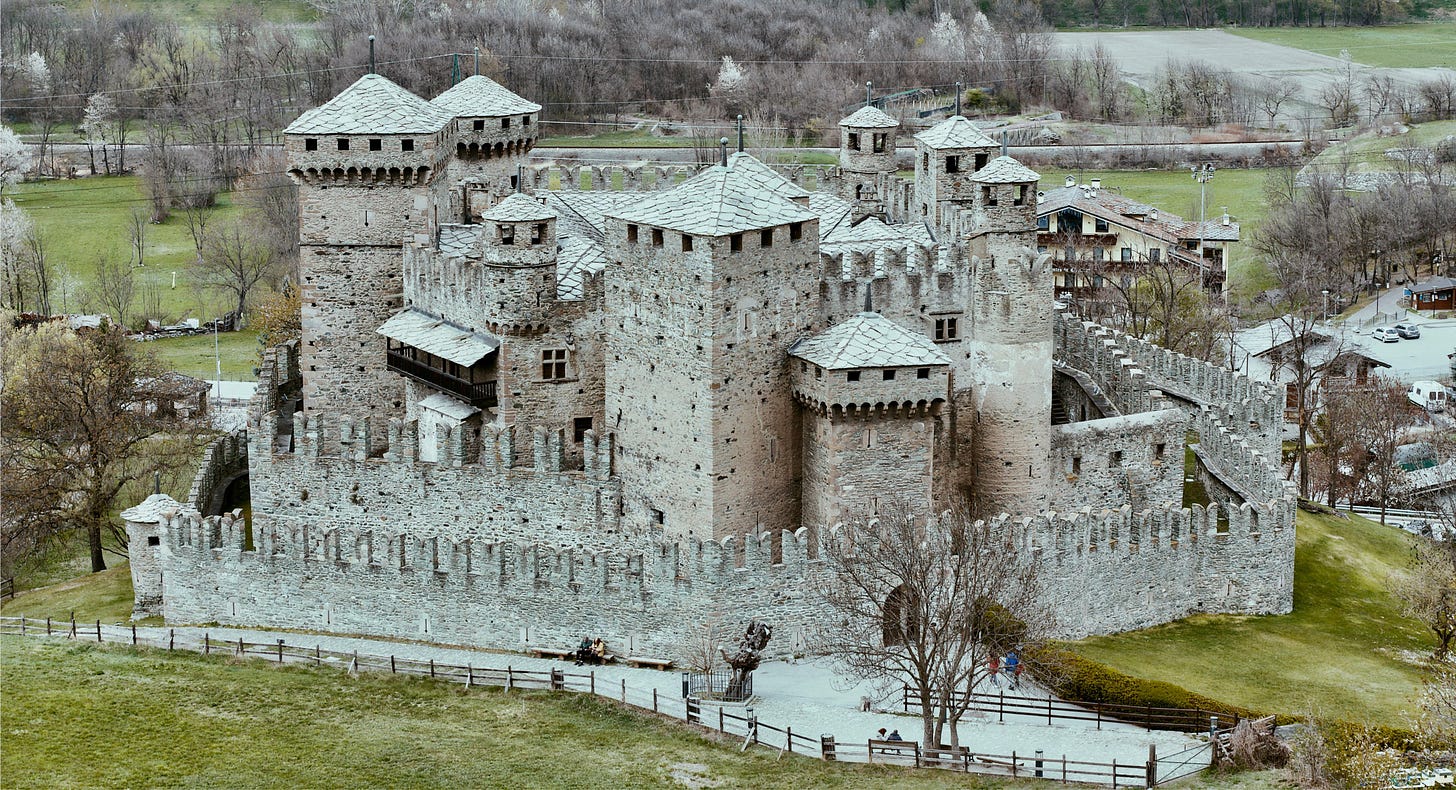A Journey Through Aosta’s Castles: Tales of Strategy, Status, and Splendor
I spoke to Aosta's Viviana Vallet about the unique stories behind the valley’s iconic fortifications and their enduring legacy in Alpine heritage.
Earlier this year I was driving home from Italy via the Aosta Valley and couldn’t help noticing the stunning castles along the route. Normally, I’m looking at the rocks for climbing on.
But I discovered the region is known not only for its beautiful mountains but also for its many castles. To find out why there are so many of them, I spoke to Viviana Vallet, Head of Historical-Artistic Heritage and Cultural Site Management for the region. She explained the history, architecture, and cultural significance of these magnificent buildings.
Châtel-Argent Castle
Châtel-Argent Castle, located near Villeneuve, is a medieval fortress perched on a rocky promontory overlooking the Dora Baltea River. Its strategic position offered control over the valley's main routes.
Why Are There So Many Castles in the Aosta Valley?
"Castles, towers and fortified houses sprang up here between the 11th and 12th centuries for control over the limited arable land in this rough terrain and above all for control over the axes of the main roads. The Aosta Valley has always been a crossroads between northern and southern Europe," she said.
In the Middle Ages, these roads were hotly contested by local lords, aristocrats and the Savoy ruling family. Power was fragmented and every local noble wanted a piece of the action. Viviana explained, "The division among local aristocracies encouraged the proliferation of castles as each family wanted to mark their territory with fortified structures." Castles like Châtel-Argent, Saint-Germain and Cly were not just defensive structures but status symbols, a reminder of the family’s power over their part of the valley.
Cly Castle
Situated in Saint-Denis, Cly Castle dates back to the 11th century. This imposing structure features a massive keep and offers panoramic views of the surrounding area.
The Evolution of Castle Architecture
Over time these castles changed significantly, from basic fortifications to more elaborate residences.
"The architecture of the castles evolved with societal shifts," Viviana said. "From the early garrison towers like Graines and Saint-Pierre perched on high ground to the more refined ‘plan castles’ like Fénis and Sarriod de La Tour, which became centres of agrarian and territorial management. You can trace the rise of the nobility’s power just by looking at the skyline."
By the 15th century local aristocratic families—especially the powerful Challant family—began to transform these medieval fortresses into sumptuous homes. "They were no longer just fortresses; they became grand houses with frescoes and comfortable living spaces," she said. A prime example is Fénis Castle, renowned for its frescoes and Renaissance charm. In later centuries, castles like Quart and Sarriod de La Tour underwent further adaptations, blending medieval elements with baroque influences.
Viviana emphasised how this period reflected the influence of European courtly life, with the aristocracy adapting their castles to the elegance of European courts during the “Autumn of the Middle Ages.”
Fénis Castle
Fénis Castle is one of the best-preserved medieval castles in the Aosta Valley. Known for its numerous towers and double crenellated walls, it showcases impressive frescoes and offers insights into medieval architecture.
Aosta Castles’ Unique Features
What makes Aosta Valley’s castles different from others in Europe? "The Aosta Valley’s castles reflect a unique political climate," Vallet explained. "They are numerous, controlling small territorial units, often in possession of minor aristocratic families." This fragmented power structure led to a density of fortresses rarely seen elsewhere.
Vallet also said it’s down to some special architectural features. One of these is the cylindrical towers with helicoidal scaffolding, a design that dates back to the late 13th century."This design is actually linked to British influences, specifically the work of Master James of Saint-Georges who built many Welsh castles," she said. "It’s surprising how the House of Savoy had more connections with Britain than you would expect."
Saint-Pierre Castle
Located in the town of Saint-Pierre, this castle is notable for its fairy-tale appearance, featuring multiple turrets and a picturesque setting against the mountainous backdrop.
Castles in Local Life: Past and Present
In the Middle Ages, castles were not just seats of power but part of everyday life in the valley. "They were hubs of organisation and management for the countryside, spaces where peasants would meet the elite—whether to deliver goods, pay taxes or use shared facilities like ovens," Viviana said. "We tend to think of these lords as tyrannical figures but their relationship with the local population was far more immediate and direct than we imagine."
Today they still shape the culture of the region. "The Aosta Valley skyline would be impossible without castles," she said. "They evoke a world we can barely imagine but are the foundation of this Alpine area identity."
Conservation Today
In modern times much work is put into conserving these ancient buildings. Viviana and her team are on the front line of this so that castles like Quart and Sarriod de La Tour are preserved for the future.
"We work with restorers and external specialists to keep the castles in good shape," she said. The castles are a big draw for tourists and visitors come all year round to see the historic beauty of castles like Fénis, Châtel-Argent, and Saint-Pierre. "Cultural tourism in the Aosta Valley relies heavily on these castles. They’re not just relics of the past but living parts of our cultural landscape."
Viviana’s Favourite Castle
"It has to be Quart. It’s not open to the public yet but we’re working on a museum display that will be amazing. The views are stunning and the frescoes inside are remarkable for their depiction of medieval chivalry and courtly life. It’s a treasure trove of history waiting to be rediscovered."
Quart Castle
Quart Castle, built in the 12th century, is located near the town of Quart. Currently undergoing restoration, it boasts remarkable frescoes depicting medieval chivalry and courtly life. Photo by: Hagai Agmon-Snir
Final Thoughts
If you’re coming to the Aosta Valley Viviana recommends keeping an open mind. "What visitors overlook is the huge variety of castles here—each one has its own story and architectural features," she said. "Visiting them is like going back in time, from the primitive medieval fortresses to 19th-century mansions."
So whether you’re a history enthusiast or just someone who likes a bit of romance and glamour the castles of the Aosta Valley will get under your skin. As Viviana said, "These castles may be old but they still have plenty of stories to tell."








